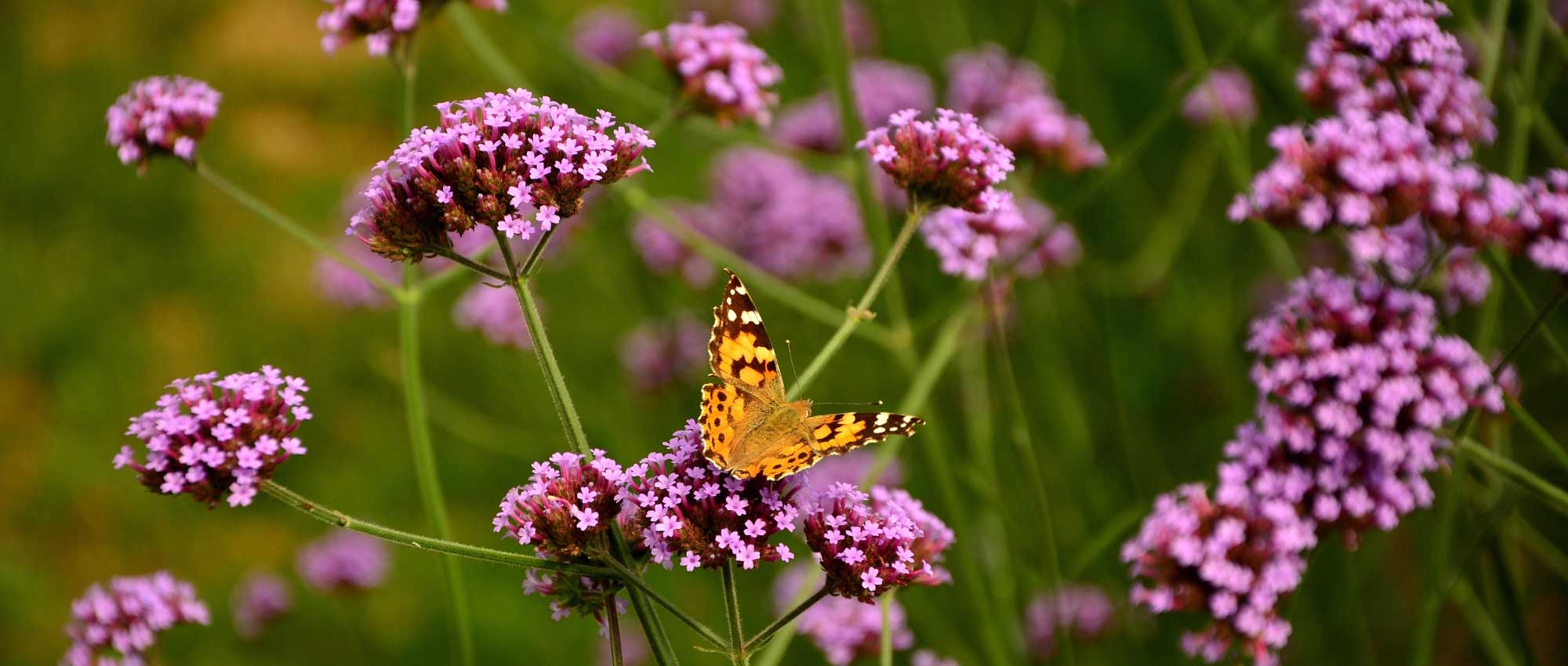
Verbena: planting, pruning and care
Contents
Verbena in a nutshell
- Ornamental verbenas offer very long flowering, from early summer through to the first frosts
- Lemon verbena is a medicinal and aromatic plant that can be enjoyed as herbal tea
- Hybrid varieties offer very colourful flowering and are ideal for planters!
- Buenos Aires verbena fits wonderfully into naturalistic borders
- Verbenas are easy plants to grow
- They thrive in full sun, in fertile, moist and well-drained soil
A word from our expert
Verbenas form a diverse group of plants, cultivated either for their aromatic and medicinal interest, or for their colourful, highly decorative flowering. Thus, Verbena officinalis and lemon verbena (also called scented verbena) are medicinal plants that can be consumed as herbal tea, with many benefits. Garden verbenas (also called hybrid verbenas or annuals), Buenos Aires verbena and hastate verbena are grown for their very decorative flowering. Garden verbenas are compact plants that produce very colourful flowers. They are perfect in window boxes or pots. Buenos Aires verbena and hastate verbena are large plants with a very natural habit, carrying beautiful mauve flowering, light and airy in appearance.
Verbenas are fairly easy to grow. They enjoy full sun, in ordinary, well-draining, cool soil. Buenos Aires verbena and hastate verbena are better suited to planting in open ground, while garden verbenas and lemon verbena are very suitable for growing in pots. Hybrid verbenas will appreciate a few waterings during summer. As for lemon verbena, we suggest pruning severely at end of winter. It also needs protection from cold in winter, as it is a rather frost-sensitive plant. Discover all our advice for successfully growing these different verbenas!
Description and botany
Botanical data
- Latin name Verbena sp.
- Family Verbenaceae
- Common name Verbena
- Flowering between June and October
- Height between 20 cm (hybrid verbenas) and 2 m (Verbena bonariensis)
- Sun exposure full sun
- Soil type ordinary, fresh, well-drained, moderately fertile
- Hardiness Variable. Hybrid verbenas and lemon verbena are frost-tender; perennial verbenas tolerate −15 °C.
Verbenas are plants grown for their decorative flowering or for their aromatic interest. They can be perennial or annual, herbaceous or semi-woody. Most species originate from Americas. Thus, unsurprisingly, Buenos Aires verbena (Verbena bonariensis) comes from South America; as do Verbena hortensis, which gave rise to hybrid verbenas (or garden verbenas); but lemon verbena, Aloysia citriodora, also has the same origin. In wild state, verbenas mainly grow in open, sunny habitats such as meadows, fallow land and roadside margins, which explains why they appreciate being planted in sun.
Verbena officinalis (Verbena officinalis) is a common plant in nature in France. It is very discreet, with fine stems that look relatively translucent, and tiny pale mauve flowers. Despite its considerable medicinal interest, it mostly goes unnoticed!
Hybrid verbenas (Verbena x hybrida) are valued for their very colourful flower displays. They are perennials, but usually grown as annuals. They are also called “garden verbenas”. Originally derived from Verbena hortensis, they have produced many varieties in a wide range of often vivid colours.
Verbenas belong to family Verbenaceae, from which they take their name. This family includes just over 1,000 species. In addition to verbenas, it includes some other ornamental plants, notably Lantana and Duranta repens.
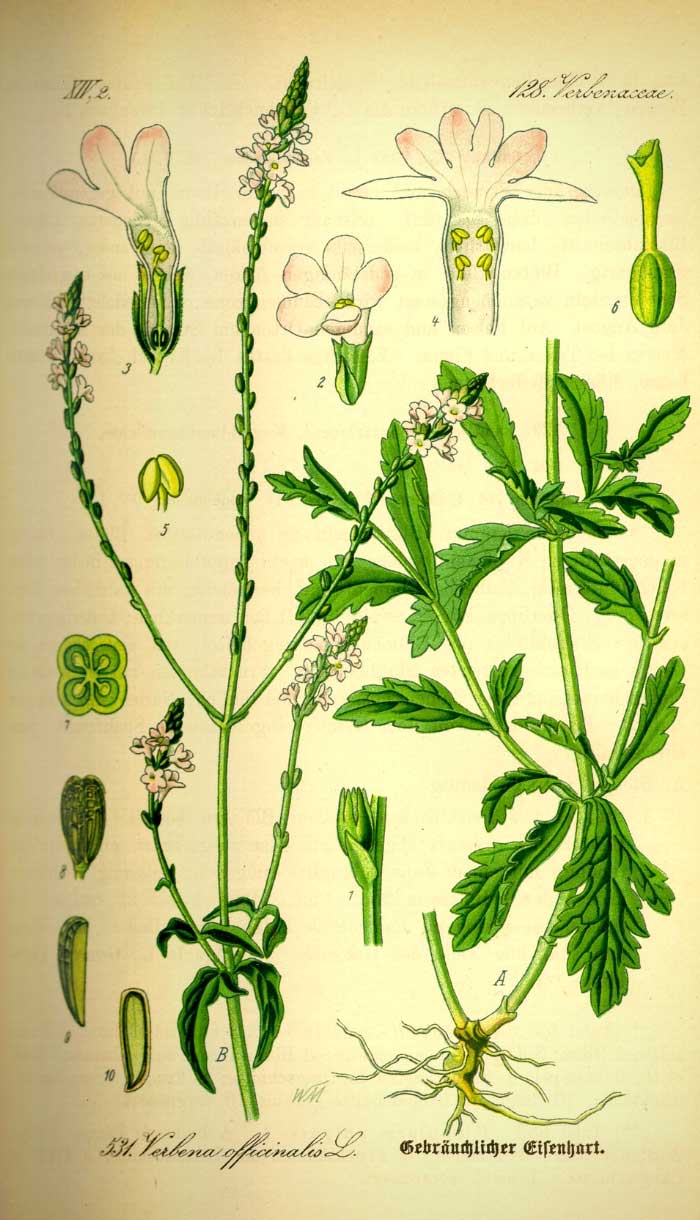
Verbena officinalis: botanical illustration
Strict verbenas, botanically (genus Verbena), include about 100 species. But other plants that do not belong to genus Verbena are also called verbenas: this is the case for lemon verbena (Aloysia), bog vervain (Lippia nodiflora), and genus Glandularia. All these plants are nevertheless linked to family Verbenaceae, and are therefore very close to true verbenas.
Verbena bonariensis and Verbena hastata are fairly tall perennials, reaching between 1.50 m and 2 m. They bear long, erect, ramified stems that give the plant a light, airy appearance, allowing the eye to see through them. These verbenas add volume and verticality to borders and can be used to lighten somewhat flat beds or those with overly bold flowering. Hybrid verbenas are much lower, not exceeding 50 cm in height. They are compact, bushy plants, but can also take a fairly wide, spreading form. Some have a trailing habit, making them very decorative in hanging baskets. Lippia nodiflora has a completely different habit, being a very low, mat-forming plant that can be used as a lawn substitute. Verbena tenuisecta is another spreading-form verbena.
Perennial verbenas, such as Verbena bonariensis or Verbena hastata, do not live very long, but they tend to self-seed!
Stems of Verbena bonariensis are ramified with opposite branching: each time, two stems grow face to face, giving the plant a very symmetrical, regular aspect. This plant brings strong graphic interest to beds, especially as its stems are relatively rigid.
Verbenas have the advantage of flowering for a long time ! They flower from early summer (sometimes from late spring), until the frosts. Flowering generally occurs from June to October, but this also depends on the variety grown.
Verbena flowers consist of five petals. They are fused into a tube, as are the small sepals that surround them. The sepals form five teeth (corresponding to five fused sepals). Inside the corolla tube are inserted four stamens (male parts bearing pollen) and the pistil (female part receiving pollen). Verbena flowers are slightly irregular, with bilateral symmetry. They are borne terminally at stem tips.
Verbena flowers are generally mauve, but those of hybrids range in white, red, pink, violet, blue. Colours of hybrid verbenas are often vivid, bright; whereas those of Buenos Aires and hastata verbenas are much softer.
Perennial verbenas, Verbena bonariensis and Verbena hastata, offer a delicate mauve flowering, as does Verbena officinalis. These plants integrate perfectly into naturalistic gardens. Their flowers are small, not exceeding 5–6 mm in diameter. Those of Verbena bonariensis have a light, rather luminous hue, emphasised by the darker sepals and bracts that bear them. They are gathered in flattened panicles, while those of hastata form fine, small spikes.
In a very different, much more colourful register, annual verbenas are impressive for their flowering. They can display a wide colour range: pink, red, white, mauve, blue, even orange… Some hybrid verbenas even bear bicoloured flowers: for example pink with white streaks in Verbena ‘Coral Star’ or blue with a white centre in ‘Lilac Eye’. In Estrella series varieties, flowers are marked with white forming a star pattern.
Inflorescences of hybrid verbenas are not at all the same shape as those of Buenos Aires, officinalis or hastata verbenas. Their flowers are large, up to 3 cm in diameter at most, and are gathered in fairly dense, flattened clusters. They somewhat resemble Phlox flowering.
Lemon verbena, meanwhile, produces a delicate white flowering in summer, made up of small flowers.
Buenos Aires verbena is a good melliferous plant. Its flowers attract pollinating insects (bees, butterflies…).

Flowering of lemon verbena (Aloysia citriodora – photo H. Zell), of Verbena hastata (photo James St. John), and of hybrid Verbena lanai ‘Purple Star’
Verbenas bear green, simple-shaped leaves, not divided but dentate along the lamina margin. Leaves are opposite, placed two by two, one facing the other. Leaves of hybrid verbenas are attractive, with finely dentate lamina margins.
Leaves of Verbena bonariensis are very narrow, making them discreet. They are mainly borne on lower part of the plant. Upper parts of stems bear only flowers, which makes plant very light and airy.
Lemon verbena carries a lovely light-green foliage with entire, elongated lamina. Its leaves are, of course, very fragrant. They have a pleasant lemon scent and possess medicinal properties. They are often consumed as an infusion, but can also be used in cooking to perfume desserts or dishes. They can also be used in potpourri with other spices, leaves and flowers.

Foliage of lemon verbena (Aloysia citriodora – photo Plenuska), of Verbena hastata and of Verbena bonariensis
When flowering has finished, if flowers are left on plant, verbenas produce capsules containing seeds. These capsules open on ripeness to release seeds and enable plant to spread.
Seeds of Verbena bonariensis and hastata are appreciated by birds! They are good plants for a garden favourable to biodiversity, as their flowers are also very melliferous.
Buenos Aires verbena tends to self-seed, which compensates for its relatively short lifespan!
Hybrid verbena is a frost-tender plant; this is why it is usually grown as an annual. Lemon verbena also has the drawback of being only slightly hardy (−5 °C), whereas Verbena bonariensis is more resistant, tolerating down to −10 or even −15 °C.
Main verbena varieties
They are mainly Verbena bonariensis and Verbena hastata. They are fairly tall, have a light, airy appearance, and fit easily into naturalistic, wild or country-style gardens.
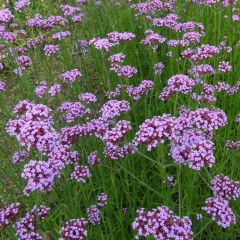
Verbena bonariensis - Purple Top
- Flowering time July to November
- Height at maturity 1,20 m
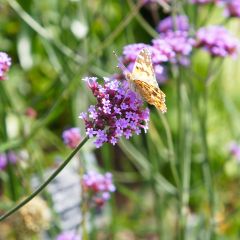
Verbena bonariensis Lollipop
- Flowering time July to October
- Height at maturity 60 cm
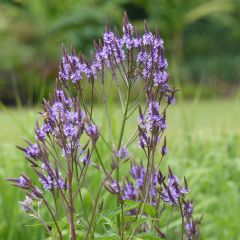
Verbena hastata
- Flowering time August to November
- Height at maturity 80 cm
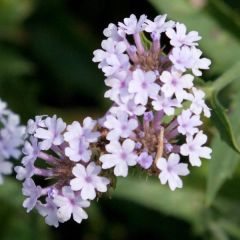
Verbena Polaris
- Flowering time July to December
- Height at maturity 50 cm
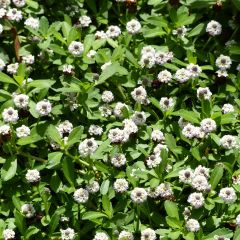
Phyla nodiflora - Capeweed
- Flowering time June, July
- Height at maturity 5 cm
Also called garden verbenas or hybrid verbenas (Verbena x hybrida). They are in fact perennial plants but frost-tender, and are therefore usually grown as annuals. Valued for their flowers gathered in dense clusters. Perfect for compositions in window-boxes or pots, and also suitable for planting at the front of borders.
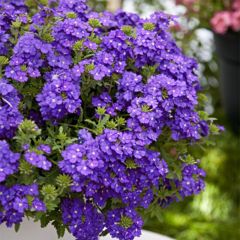
Verbena Vepita Pearl Blue
- Flowering time July to November
- Height at maturity 25 cm
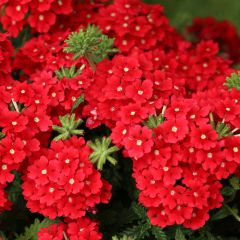
Verbena Superbena Royale Red
- Flowering time July to November
- Height at maturity 25 cm
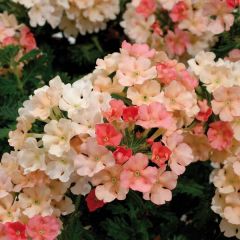
Verbena Superbena Royale Peachy Keen
- Flowering time July to October
- Height at maturity 25 cm
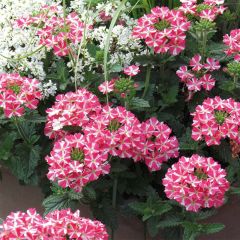
Verbena Superbena Coral Star
- Flowering time July to November
- Height at maturity 30 cm
These include lemon verbena (Aloysia triphylla) and Verbena officinalis.
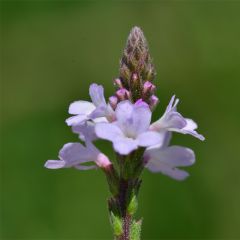
Organic Vervain - Verbena officinalis
- Flowering time July to November
- Height at maturity 60 cm
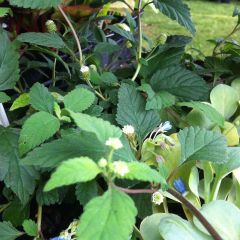
Lippia dulcis - Aztec Sweet Box
- Flowering time July to October
- Height at maturity 15 cm
Discover other Verbena - Vervain
View all →Available in 0 sizes
Available in 2 sizes
Available in 1 sizes
Available in 1 sizes
Available in 1 sizes
Available in 4 sizes
Available in 1 sizes
Available in 1 sizes
Available in 1 sizes
Planting verbenas
Where to plant?
Verbenas prefer full sun. They need at least 6 hours of sun per day to produce abundant flowering, or strongly aromatic foliage (lemon verbena).
Hybrid verbenas appreciate rich, fertile soils. It is best to add some well-decomposed compost or fertiliser. They also like soils that remain relatively cool in summer while being free-draining.
Verbena bonariensis grows well in free-draining ground, even dry and stony, and tolerates fairly poor soils. It does not like heavy substrates that retain moisture in winter.
Lemon verbena needs free-draining, rather poor soil.
Verbena bonariensis and hastata are excellent plants for naturalistic gardens or perennial borders, while hybrid verbenas are better suited to window boxes, pots, hanging baskets or edgings. As for lemon verbena and common vervain, they can be integrated into vegetable gardens or an herb and medicinal plant bed.
If you grow lemon verbena, unless you live in very mild climate, we recommend planting it in a pot so you can bring it indoors in winter to protect it from cold.
When to plant?
Plant verbenas in spring, as soon as risk of frost has passed.
How to plant?
We suggest spacing hybrid verbenas about 30 cm apart, and at least 40–50 cm for other verbenas.
In open ground:
- Start by placing the rootball in a tub of water to let it soak. This will make later watering easier and improve establishment.
- Dig a planting hole. It should be about three times the size of the rootball. If growing hybrid verbenas, add some well-decomposed compost. If soil is heavy and tends to retain water, add draining materials: gravel, coarse sand…
- Plant your verbena.
- Replace soil around and firm with the flat of your hand.
- Water generously.
Remember to water regularly in the weeks following planting.
For container planting:
Hybrid verbenas adapt well to container culture. Likewise, lemon verbena, being not very hardy, can easily be planted in a pot and brought under cover in winter.
Take a pot or window box, then place a drainage layer at the bottom (this can be gravel, clay balls, or other coarse material). Add compost, then position the plant. For hybrid verbena, you can mix a little slow-release fertiliser into the substrate. Fill in with substrate around the plant, then firm and water.
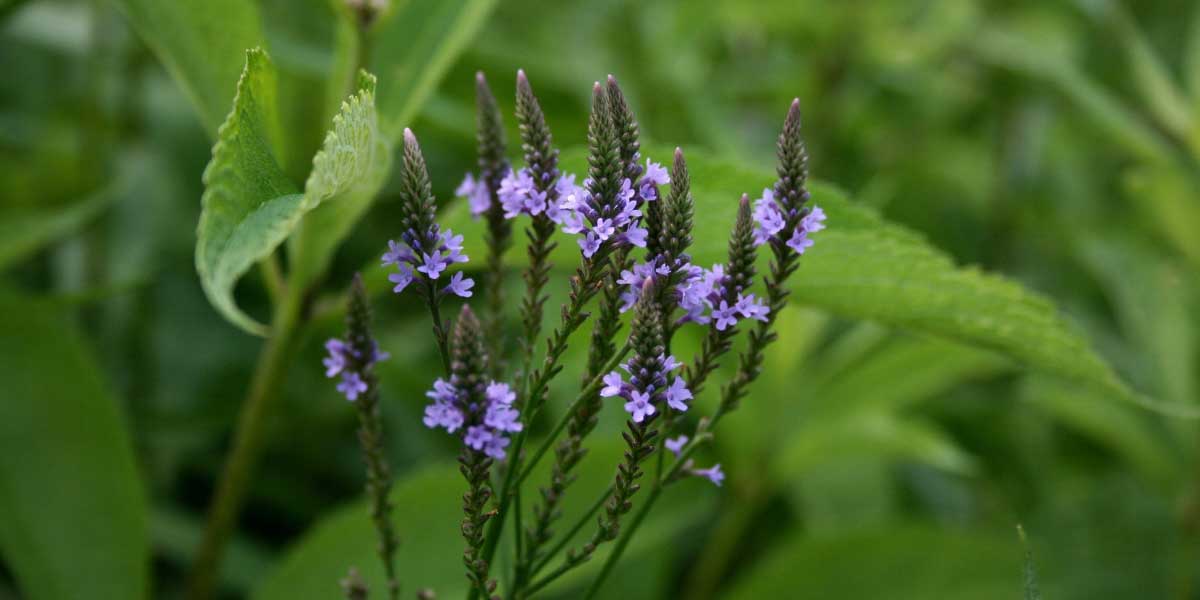
Verbena hastata (photo: Cody Hough)
Care
Buenos Aires verbena tolerates drought fairly well and requires little care. It is ideal in wild, natural-style gardens where little intervention is needed.
Hybrid verbenas, however, require a little more care. They will appreciate additions of compost. If you grow them in pots or window boxes, you can apply some liquid fertiliser, or use slow-release fertilisers. It is also preferable to water them during summer. Make sure the substrate does not dry out too much. Be especially vigilant if you grow it in a pot, as the substrate dries faster than in open ground. When you water, direct the jet of water at the base of the plant, avoiding wetting the foliage, to limit disease development.
Regular watering in summer ensures a more generous and longer flowering. Feel free to apply a mulch so that the soil stays relatively cool.
We recommend removing the flowers of hybrid verbenas when they are spent, as this relieves the plant and encourages it to produce new flowers. For Verbena bonariensis, leave them in place to allow the plant to self-seed and naturalise in your garden!
Hybrid verbenas are generally grown as annuals. You can renew your window boxes each spring, or choose to keep them from one year to the next by bringing them under cover for winter when temperatures become cool.
You can harvest the leaves of lemon verbena, then use them fresh or dry them.
Lemon verbena is quite tender; it must be protected from cold by bringing it under cover for winter (hence the advantage of growing it in a pot). If you live in a region with a particularly mild climate, you can simply protect it with a thick mulch and a horticultural fleece.
We suggest cutting back lemon verbena at the end of winter (February–March), pruning its stems severely. This makes it bushier and more compact by forcing it to become ramified. Also carry out some lighter prunings during summer, cutting stems back by a quarter to a third of their length.
Also remember to harvest its leaves, to use them fresh or dry them! Learn more with our tutorial How to dry and store lemon verbena?
For lemon verbena as for hybrid verbenas, carry out regular watering during summer.
For Verbena bonariensis, you can prune the plant at the end of winter–start of spring. It is also possible to cut the plant back in autumn, after flowering, if you wish to prevent it from self-seeding in the garden.
Diseases and parasitic organisms
Most verbenas are susceptible to powdery mildew. This disease is caused by tiny fungi and is identified by a felt-like white coating on the foliage. Treat using sulphur or a horsetail decoction. Hybrid verbenas can also be affected by downy mildew, another fungal disease. Against these fungal diseases, avoid excess moisture, avoid planting too densely to allow air to circulate, and do not wet foliage when watering (direct water to base of plant). Once disease has developed, to limit spread we recommend cutting and burning affected parts, then using a fungicidal treatment (bicarbonate of soda, sulphur, Bordeaux mixture…).
Regarding pests, verbenas are sometimes nibbled by slugs. You can lay sawdust or sand around your young plants to prevent slugs accessing them, or, if that is insufficient, use slug pellets (Ferramol). Likewise, aphids can attack verbenas. In that case, treat by spraying foliage with black soap diluted in water. Red spider mites can also settle on verbena. They are tiny mites that pierce leaves and feed on sap. Finally, you may also encounter problems with thrips.
Lemon verbena is sometimes attacked by whiteflies.
Multiplication
Best techniques for multiplying verbenas are sowing and propagation by cuttings. We recommend propagation by cuttings, which has advantage of being fairly simple and quick, and which seems suited to majority of species, whether hybrids, perennials or aromatic verbenas. Buenos Aires verbena can also be multiplied by dividing clumps.
Sowing
You can sow hybrid verbenas and perennial varieties in late winter, around March. Pots should be kept under cover, then planted outdoors in spring as soon as risk of frost has passed. In all cases, we recommend placing seeds in the fridge for 10 to 15 days before sowing to help germination.
- Prepare a pot or seed tray, filling it with seed‑sowing compost
- Place seeds on the surface.
- Then cover lightly with substrate. Firm gently.
- Water with a fine spray.
- Keep the pot under cover, in a bright spot without direct sun. Ideal temperature is around 20 °C.
- Continue to water regularly, then plant young plants in garden in spring, when risk of frost has passed, from May.
Buenos Aires verbena can also be sown directly in situ, in open ground.
Propagation by cuttings
You can propagate hybrid verbenas, perennials and lemon verbena at end of summer, around August–September.
- Take a healthy stem, preferably not in flower. It should be about 10 cm long. We recommend making a clean, sharp cut just below a node (point where leaf attaches).
- Remove leaves from lower part of stem, leaving only a few at top of cutting. If stem bears flowers, remove them too.
- Prepare a pot with light potting compost, to which you can add a little sand or perlite. Water so that it is evenly moist.
- Insert the stem into the substrate.
- Firm the compost around it to ensure good contact between compost and stem.
- Keep the pot under cover, in shade. You can optionally place the cutting in a humid microclimate by putting a plastic bottle over the pot so the atmosphere is saturated with moisture.
- Continue to water regularly so substrate remains moist while cutting starts its growth.
- You can plant young plants in open ground in spring, once risk of frost has passed.
For lemon verbena, heel cuttings are possible, taking a stem with a small segment of the branch at its base.
Companion planting verbena in the garden
Verbena bonariensis and Verbena hastata fit easily into a naturalistic garden. These verbenas have a transparent, airy appearance that lets the eye travel through. They lend a wild, country feel to the garden. Plant them with other naturally looking plants: Gaura lindheimeri, Veronicastrum, Echinops, knautias, Phlomis russeliana, teasel (Dipsacus fullonum), Salvia nemorosa… You can also create a stunning late-summer border in a natural style, in tones of purple, orange, brown and mauve. Plant Eupatorium maculatum, Echinacea purpurea, and grasses such as Pennisetum, Calamagrostis or Miscanthus.
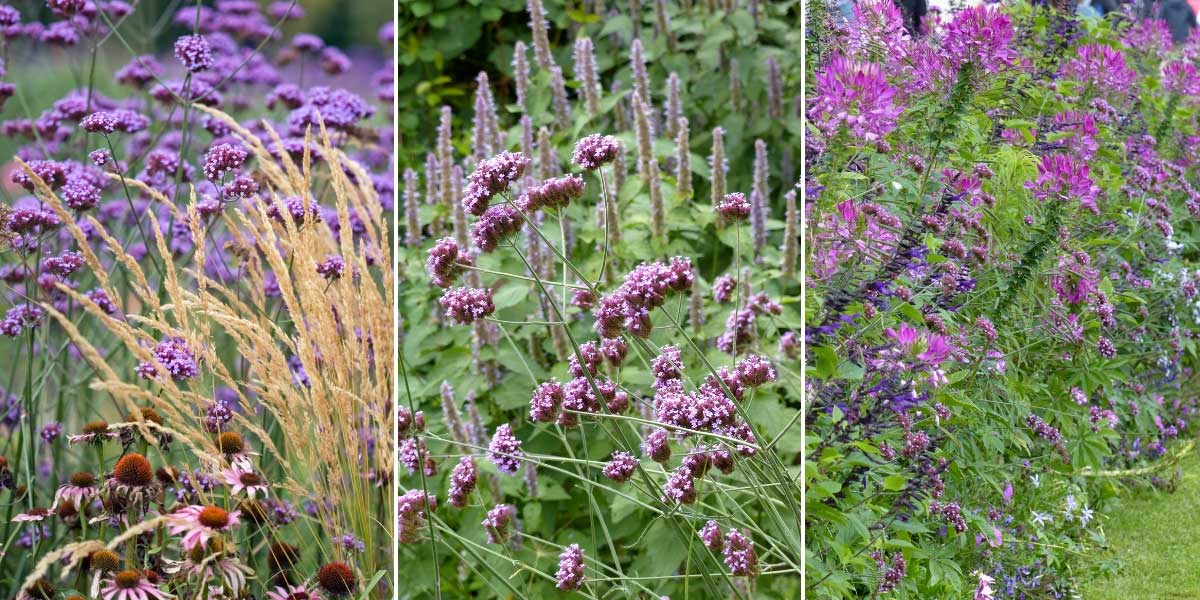
Buenos Aires verbena is perfect in naturalistic gardens! Verbena bonariensis, Calamagrostis ‘Karl Foerster’ and Echinacea purpurea (photo GWI – Jenny Lilly – MAP) / Verbena bonariensis and Agastache ‘Blue Fortune’ / Verbena bonariensis, Cleome ‘Violet Queen’ and Salvia ‘Amistad’
These verbenas can also be used to bring lightness to perennial borders, alongside plants with large flowers or broad, low foliage. They will nicely set off brighter flowerings such as coreopsis, dahlias, daylilies or bidens. They can add a contrast of form to lift a somewhat flat border dominated by broad, ground-hugging foliage such as bergenias, heucheras or alchemilla.
As these verbenas are fairly tall, place them towards back or middle of borders, while hybrid verbenas should be placed at the front.
Verbena officinalis and lemon verbena work well in aromatic and medicinal herb gardens. Plant them with mallows, salvias, hyssops, marigolds… Plants you can harvest, dry and use for infusions. Verbenas also have a place in the vegetable garden, among vegetables and aromatic herbs.
Annual verbenas are ideal in containers, pots or hanging baskets. You can create beautiful colourful compositions by pairing them with Scaevola aemula, Lobelia, nemesias or diascias. Also include Carex, Muehlenbeckia and ornamental-leaved Ipomoea. Some verbena varieties with a trailing habit are particularly suited to hanging baskets.
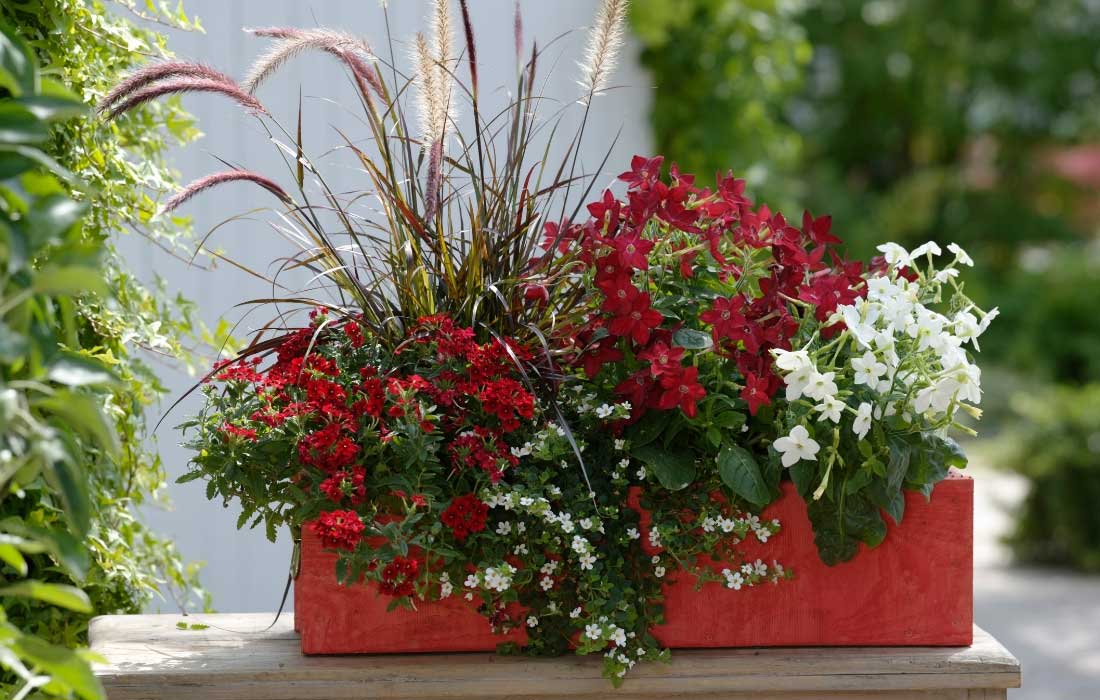
Hybrid verbenas work well in pot and container compositions. Here paired with Pennisetum, Nicotiana (ornamental tobacco) and Bacopa (Photo Friedrich Strauss – Biosphoto)
You can also take advantage of the vivid flowering of hybrid verbenas to create a very colourful summer border. As they are not very tall, place them at the front of the border and pair them with blooms of rudbeckias, lantanas, salvias, coreopsis or dahlias.
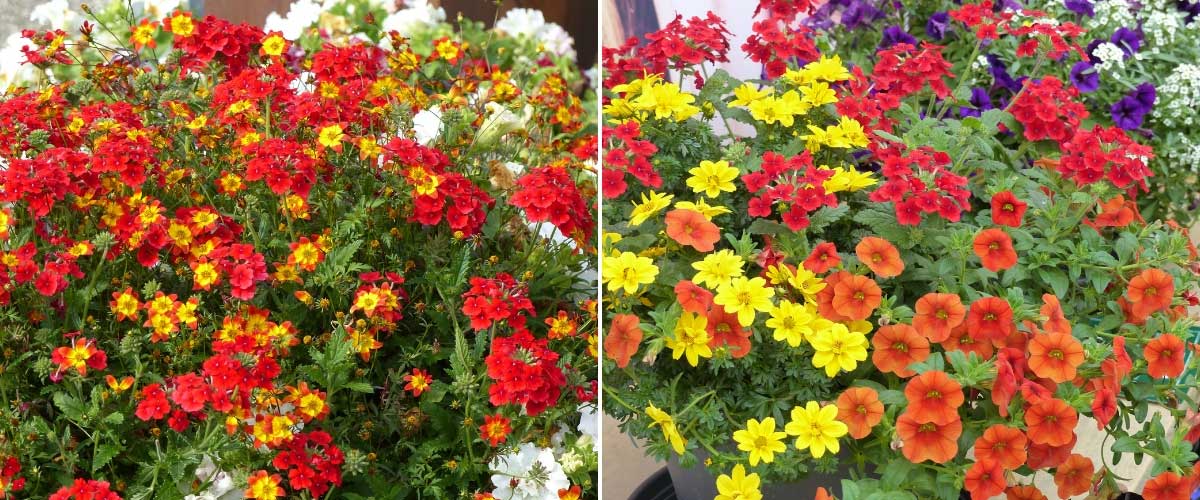
They also allow creation of very colourful scenes. Verbena ‘Temari Red’ and Bidens ‘Beedance Painted Red’ / Verbena ‘Estrella Vampire Red’, Calibrachoa ‘Noa’ and Bidens ‘Yellow Charm’
Did you know?
- Medicinal properties of lemon verbena
Lemon verbena is a plant with many virtues. It is calming, effective against stress, anxiety and depression, and aids digestion. It is commonly used as an infusion.
Common vervain, Verbena officinalis, is also known for its benefits: it is anti-inflammatory, diuretic, aids digestion and has a calming effect.
- Confusions
Be careful not to confuse lemon verbena with true lemongrass, Cymbopogon citratus. The latter is a grass, forming a clump from which long, very fine, linear leaves emerge.
Useful resources
- Our range of perennial verbenas
- Our range of annual verbenas
- An article by Michael on our blog – Buenos Aires verbena and tufted canche in an autumn duo
Frequently asked questions
-
My verbena leaves are covered with a white, powdery coating. What should I do?
Your plant is affected by powdery mildew, a disease caused by a fungus. As soon as you notice its presence, cut and burn affected parts to limit its spread. Then spray with a sulphur-based solution.
-
Leaves and young shoots appear to have been nibbled. What should I do?
Slugs are probably to blame; they like to eat young shoots in spring. To stop them reaching your young plants, scatter sawdust or sand around them to form a barrier. If that is not sufficient, use slug pellets such as Ferramol.
-
Is my verbena annual or perennial?
Tall verbenas, Verbena bonariensis and Verbena hastata, are perennial plants. Low-growing verbenas (no more than 40 cm tall), with very colourful flowers, are grown as annuals but are actually perennials! Simply protect them from frost and they will keep for several years.
-
Should I prune the plant after flowering?
For perennial verbenas, cut back spent stems if you want to avoid spontaneous sowing. Otherwise, leave them in place over winter, especially as the seeds are appreciated by birds! For hybrid verbenas and lemon verbena, you can simply remove faded flowers.
- Subscribe!
- Contents
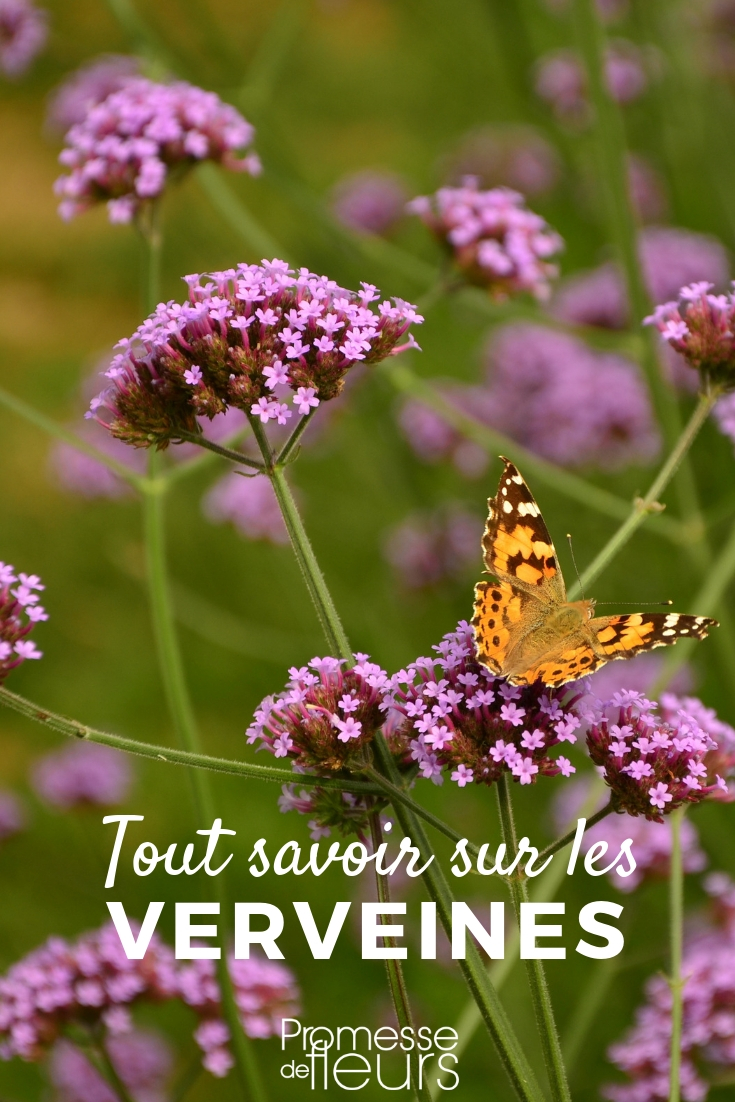































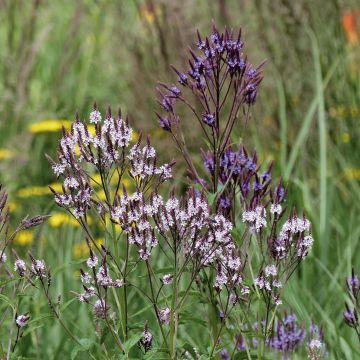


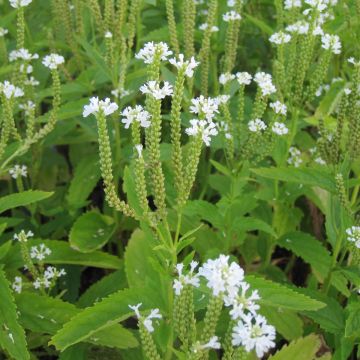
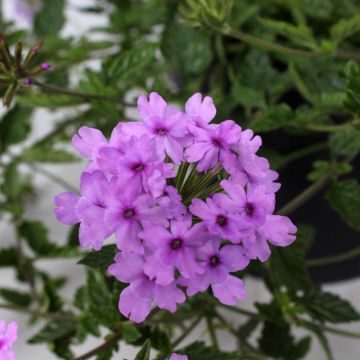

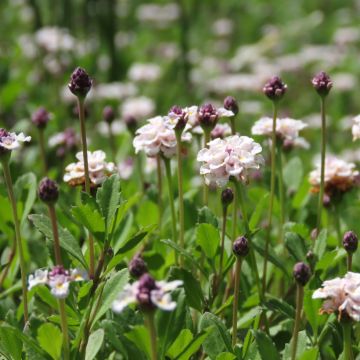
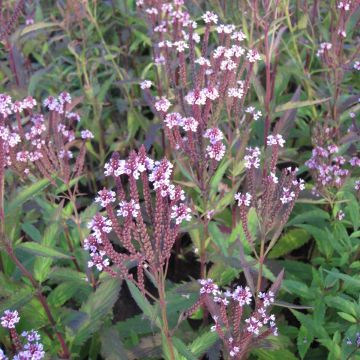
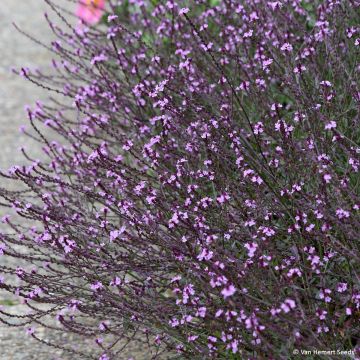
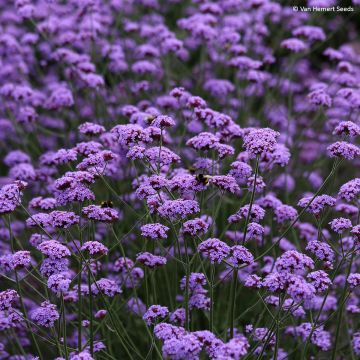
Comments